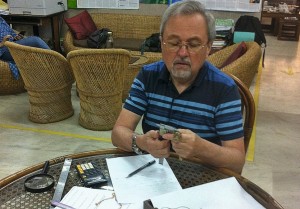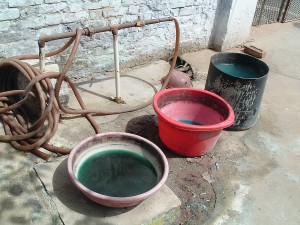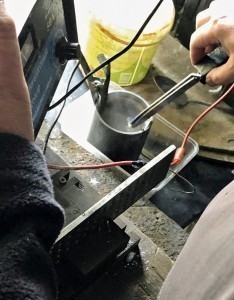Laos, India or Kyrgyzstan: Adam Vollmer provides development aid in the field of electroplating technology.
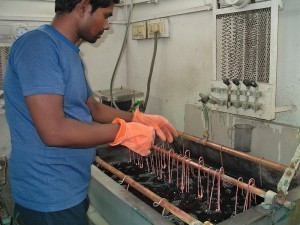 Copper wires of different thicknesses above the bath regulate the currentTheheat is unbearable. The temperature rises to 42 °C in the afternoon - but water from the tap is only available for one hour a day. At four o'clock in the morning, it starts to roar and then you have to make sure that your house tanks are filled in this district of New Delhi. The water is heavily chlorinated and not suitable for drinking. At best, you can use it for showering and cleaning. At five o'clock in the morning, this source also dries up.
Copper wires of different thicknesses above the bath regulate the currentTheheat is unbearable. The temperature rises to 42 °C in the afternoon - but water from the tap is only available for one hour a day. At four o'clock in the morning, it starts to roar and then you have to make sure that your house tanks are filled in this district of New Delhi. The water is heavily chlorinated and not suitable for drinking. At best, you can use it for showering and cleaning. At five o'clock in the morning, this source also dries up.
Adam Vollmer is used to such circumstances. He has already traveled to many exotic countries for the Senior Expert Service (SES). He is now in India, having previously been to Laos and Cambodia several times. Soon he will be heading to Kyrgyzstan.
"Tara Projects requested me from SES," explains Vollmer. "Tara is a kind of cooperative of several hundred craftsmen that also produces costume jewelry, among other things. However, the electroplated coatings start later. I'm now supposed to check the whole process," adds the senior expert.
The retired teacher from the Heinrich Wieland School in Pforzheim is staying in a guest house at the cooperative. He now fills small bottles with drinking water from a larger container, which will get him through the day. Then he goes to work. And that's not as easy as it sounds. As it's impossible to get to work by car in downtown New Delhi during rush hour, Vollmer first has to take the subway a few stops to an outlying district. He is picked up there. The electroplating plant where he works is located in Pataudi, around 60 kilometers from Delhi. He is on the road for six hours a day, three hours there, three hours back. "So the working days are long," sighs the senior expert, "and the traffic is an adventure in itself."
When Vollmer arrived in Pataudi on his first day of work, he first discovered that the workers didn't understand English. So a manager translated everything into Hindi. Unfortunately, the manager was not a technician but a businessman - so he didn't know what they were talking about.
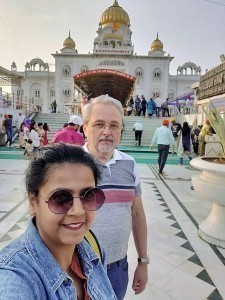 Sightseeing: Selfie at the Sikh temple in New Delhi"Such frictional losses are normal," says Vollmer, who is not fazed by them. Vollmer's start to his new job was made easier by the fact that the first problem was relatively easy to solve. Initially, the pickling solution, consisting of a mixture of nitric and sulphuric acid, was left outside - because of the NOx development. A thin film of dust floated on the liquids. Simple covers solved this problem. Since pickling was carried out first and then degreasing, the two processes were swapped. The degreasing was also cleaned.
Sightseeing: Selfie at the Sikh temple in New Delhi"Such frictional losses are normal," says Vollmer, who is not fazed by them. Vollmer's start to his new job was made easier by the fact that the first problem was relatively easy to solve. Initially, the pickling solution, consisting of a mixture of nitric and sulphuric acid, was left outside - because of the NOx development. A thin film of dust floated on the liquids. Simple covers solved this problem. Since pickling was carried out first and then degreasing, the two processes were swapped. The degreasing was also cleaned.
Then it was time for the rinsing. The water for all the rinses came from a separate well and had an electrical conductivity of 160 to 180 μS/cm. On the advice of the expert, a large ion exchanger system was procured and installed. Resistors made of spiral copper wires of different lengths and therefore with different electrical resistances were connected upstream of the four different galvanic baths. In order to find the correct amperage, the worker first coated a metal block in the form of a long droplet, which had approximately the same surface area as the product to be coated. The drop shape allowed the worker to recognize the spreading ability. During plating, he pressed various levers until he had found the right series resistor and thus the current strength. He then electroplated around 15 chains at the same time and constantly monitored the coating process. Although there were four ammeters, they were all defective.
The electroplating shop at the Tara Project had a cyanide and an acid copper bath, a brass bath and a tin bath. There were no written operating instructions for these. Presumably they would not have been of any use to the Hindi-speaking staff anyway. It was possible to obtain the required data from the supplier of the baths by telephone. Vollmer: "In this situation, the specialist books from Leuze Verlag that I took with me were a very good guide for me."
The defective ammeters were then replaced with new ones. During this time, the senior expert calculated the surface area of a chain type, the current intensity for each existing bath when ten chains were processed at the same time and the layer thickness growth per minute. As none of the employees were able to calculate even the simplest surfaces, Vollmer calculated the surfaces of other pieces of jewelry and made them available.
The ammeter on the brass bath showed that the amperage was too high and the coating was therefore increasingly burning. This was already happening at the lowest amperage that the system could supply. The employee therefore removed the chains far too early. To produce a good shine, he coated the chains in an acid copper bath for a certain period of time beforehand. He could not have known that during this time he only produced around a quarter of the coating thickness in the brass bath. In order to achieve a lower current at the bath, a supplier offered a new rectifier for 1500 dollars, an investment that was far too high for the cooperative. Here, too, Vollmer knew what to do: for 150 dollars, a series resistor was installed that served the same purpose.
Surface calculations in the office, pickling in the yard
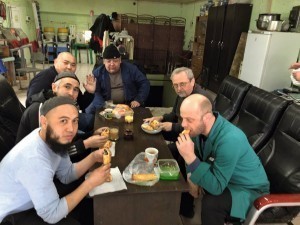 Collegial cooperation: lunch together at Kyrgyz Zerger, the food is typical of the countryWiththe now lower current density, it was possible to coat over a longer period of time and produce a thicker layer. A second anode was also used. The new coating was subjected to a 24-hour salt spray test by TÜV Rheinland. No corrosion was detected. Various new paints and an additional primer brought further improvements in quality.
Collegial cooperation: lunch together at Kyrgyz Zerger, the food is typical of the countryWiththe now lower current density, it was possible to coat over a longer period of time and produce a thicker layer. A second anode was also used. The new coating was subjected to a 24-hour salt spray test by TÜV Rheinland. No corrosion was detected. Various new paints and an additional primer brought further improvements in quality.
A special problem was the formation of bubbles in copper and brass layers on metal beads from a Zn/Sn casting process. As these items make up around 70 percent of tare production, a viable solution was important. Vollmer replaced electrolytic degreasing with solvent degreasing, which ultimately solved the problem cost-effectively.
It was pleasing that the waste from the electroplating process was disposed of properly. The sightseeing program of Delhi in the free time was also pleasing. Whenever it was not too hot, a member of staff guided Vollmer through the capital of India.
Vollmer's summary of the trip: "The mission brought many improvements. In some cases, we were even able to solve the problems quite easily and inexpensively. What I am most pleased about is that my clients also see it that way."
Inadequate conditions in Kyrgyzstan
From the heat of India to the cold of Kyrgyzstan. And in the winter month of February of all months.
This assignment also took the expert to a company that manufactures jewelry. The company was basically divided into two parts. One part consisted of a cutting/smelting shop (staffed by two employees), while the other part was responsible for goldsmith work. A total of ten employees were to be given advice on how to improve quality and Vollmer was also to commission a small electroplating shop.
Apart from the temperatures, the conditions were initially similar to those in India. There was only one man who had a very basic knowledge of English, but no knowledge of chemistry or physics.
Various processes for recycling gold-bearing waste were practiced in the refinery. However, the gold simply would not precipitate with zinc or aluminum from a gold-dithiourea complex ([Au(CN2H4S)2]+) obtained in this process. The senior expert therefore suggested that, if necessary, the solution could be narrowed down and the complex thermally decomposed. Gold-containing polishing paste and polishing wool were first thermally decomposed. The gold was then dissolved in aqua regia, filtered, the gold from the filtrate precipitated with hydrogen sulphite and then filtered again. Possible changes in the individual steps were discussed.
As metals were also remelted in this room, the air was often very poor. Added to this were the nitrous gases from the open fume cupboards, which simply discharged their exhaust gases outside. The windows were always open to improve the indoor air. As the outside temperatures were usually around freezing point, winter clothing had to be worn here.
Finally, Vollmer turned his attention to electroplating. Only a single gold electrolyte was available for the small electroplating shop to be put into operation. However, this had been developed by Umicore for tampon electroplating. With the help of a sketch in a specialist book from Leuze Verlag, Vollmer was able to explain the process to the employees to some extent. However, this was completely unknown in the company. Nobody could explain why exactly this electrolyte had been procured at some point and then later diluted. Although the senior expert was able to produce a glossy coating with it, the color was anything but satisfactory.
Other problems made life difficult. The small electroplating shop was set up in the same room as the cutting and smelting shop. As already mentioned, it was very cold there. The bath temperature was effectively room temperature due to a lack of temperature control. In addition, there was not a single thermometer. Other essential measuring equipment was also missing. As there were no operating instructions for the gold electrolyte, Vollmer suspected that it was a copycat product. Although it was possible to buy electroplating baths in Bishkek, no written documentation was obtained from the dealer himself when pressed. Vollmer finally contacted Umicore, who forwarded his inquiry to Heimerle und Meule in Pforzheim. Vollmer received quick and comprehensive advice. Vollmer then showed the instructions of use to the client to show him the standard in the EU. However, the delivery time would have been at least six weeks - too long for Vollmer to be present.
The Kyrgyz conclusion was therefore rather sobering: "Unfortunately, I was unable to fulfill the wish to put the small electroplating plant into operation. At best, I was able to achieve small successes. When electropolishing gold rings, for example, the polishing process only took place on the outside of the rings. I constructed an inner anode using a simple wire. This made it possible to polish the inside of the rings as well."
INFO
The Senior Expert Service (SES)
SES is a foundation of the German economy. The experts are mainly deployed in developing and emerging countries.
Small and medium-sized enterprises, public administrations, trade associations, social and medical institutions and educational establishments are the main beneficiaries of the experts' knowledge. In Germany, young people are supported in school and training.
All SES assignments follow the principle of helping people to help themselves. Their aim is to transfer knowledge and experience to improve the future prospects of others.
The Senior Expert Service provides its experts with enriching experiences and encounters with people and cultures that cannot be taken for granted - experiences that continue to have an impact in our society after they return home.


